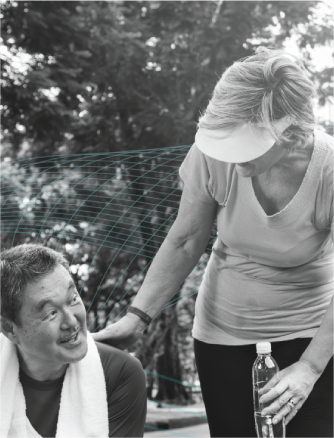Google how to treat chronic disease and you’ll find plenty of articles around diet, inactivity, smoking and stress. It’s no surprise. We know that improving our diets and exercise regimens, quitting smoking, and managing stress are powerful steps toward combatting diabetes, heart disease, hypertension and stroke, to name just a few of the top chronic diseases.
If taking care of our health is as simple as eating better and walking, why are the statistics surrounding chronic illness worse now than they were 10 years ago?
People like the idea of exercise. Every January fitness centers thrive with new members and it’s hard to find a parking place at the local YMCA. But like sticking to a diet, the newness wears off and by April many of us end up cancelling our gym memberships. We know we should diet and exercise. But we just don’t. Or we start. Then we stop. And this is one of the reasons battling chronic disease is so difficult. Doctors tell patients what they should do. And patients go home and do what they want to do.
Meeting People Where They Are
In an article for the Clayton Christensen Institute for Disruptive Innovation, Michael Devonas captures the crux of the issue of patient adherence: “When asked to follow protocol in the existing treatment model, the perceived benefits are often too small, and the time and energy cost too big. Within the context of everyday life, this model helps us understand why patients adhere to therapy – and why they don’t.”[1]
If a person doesn’t perceive the payoff to be worth as much as the time and effort involved, how likely is it that he will adhere to his doctor’s orders?
Instead of trying to change human behavior, we need to find a way to work with those behaviors to help people deal with the overwhelming financial and emotional burdens that come with chronic disease. Part of the answer is giving people information in a timely manner through daily digital prompts, and part is providing tools, like user-friendly medical grade wearables, they will use.
Let’s take a fictional person named Jane who is on the brink of becoming diabetic, teetering on that dangerous edge of her blood sugar level going over the safe number. The scenario might go something like this: With normal protocols, Jane has to wait six months in between blood tests at her doctor’s office. Jane has her glucose levels checked and she is at 111. The doctor tells her she is close to being pre-diabetic and needs to start exercising and watching her diet for the next six months. So Jane goes home, walks a few blocks that night and eats a salad for dinner. This might continue for a week until she comes home to an empty pantry, is worn out from a long day and decides to have a pizza delivered. The next day is Friday and a co-worker brings pastries into the office and everyone is having one. Jane decides that eating one won’t make that much difference. Back to her old habits, Jane continues along like this for the next five months until a few weeks before her next labs are due and realizes she needs to abstain from all sugars for two weeks so that her numbers will look good.
People either forget quickly – or live in denial – and when the problems on the inside aren’t showing on the outside, we don’t stick to health regimens.
The problem? Jane has to wait too long for input about her condition. And Jane’s not alone. People with diabetes aren’t the only ones who can benefit from daily digital prompts. Patients with chronic conditions need to control risk factors on a regular basis. Heart disease patients, for example, need to watch their food intake, make sure they exercise, and also need to stay on top of their vital signs, such as blood pressure. Some heart patients need to be monitored for possible arrhythmias. Access to data on a daily – or hourly – basis can mean the difference between living a subpar life or being able to live it to the fullest.
Daily Digital Prompts
Maybe if we had a paradigm shift where we received digital prompts full of information on a regular, daily basis about our vital signs we could grasp the gravity of our situations and make more of an effort to take action. If we had easy-to-use tools that gave us medical-grade data about ourselves, the same data that our doctors receive, maybe it could keep us on track. If we could access medical-grade information about our conditions every day, almost in the same way we can see our weight with a bathroom scales, perhaps we would be encouraged with small victories and keep staying the course. Or, we would see when we were slipping and could make changes before it became insurmountable.
Knowing our glucose levels ARE getting dangerously close to the diabetic level without having to wait the full six months before our next trip to the doctor could help us resolve to keep our gym membership or at least continue to walk around the block. Seeing our blood pressure climb could help us back off of a stressful project and take a few minutes to meditate or relax with our favorite music.
We are living in denial because we don’t immediately see the effects of our bad habits. When it’s too late, when our habits slide us down that slippery slope into full-blown chronic illness, then we throw up our hands and depend on a doctor or a drug to save us.
Medical-Grade Wearables Offer an Answer
In an article for HIT Consultant, Nick van Terheyden, MD, discusses the benefits of giving people more access to information about their conditions through digital prompts in an effort to deal with chronic disease. Terheyden says, “The wearable movement is about ushering in an era of awareness, and not in a navel-gazing way. It is about becoming more cognizant of our bodies and the impact our daily actions, such as taking the stairs over the elevator, have on our overall health. It is about accountability, both to ourselves and to others— if we say we want to start exercising more, we can track it and measure it. Wearables are just one example of how the industry is beginning to design scalable solutions that help people live better, healthier lives while simultaneously alleviating some of the pressures on our costly, complex, and overwhelmed healthcare system.” [2]
Giving patients medically relevant, clinical-grade data and providing real time feedback via digital prompts that include a benchmark of their condition and information about next steps can keep people on track who are on the threshold of developing chronic disease or who are trying to overcome one.
[2] http://hitconsultant.net/2015/06/30/wearables-empowering-healthier-population/?trendmd-shared=0






